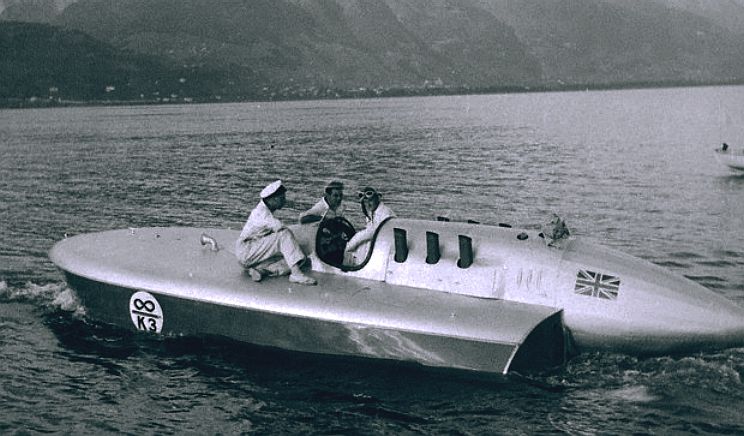I’ll make this fast — because it’s July 21, after all, the day Louis Rigolly became the first person to drive a car faster than 100 mph. He did it in 1904, on a beach in Belgium (a good choice; today is Belgium National Day there). He drove a French Gobron-Brillié racing car. Gobron-Brillié made cars through 1930 — fast ones. Their cars were used to set a number of records and competed (and won) in early Grand Prix and hill-climb races.
During World War I, Gobron-Brillié manufactured the first French tanks, which they called “terrestrial battleships.” But being tanks, they were pretty slow, so never mind. They were always more successful at making cars go fast than at selling them, and the company went under in 1930.
Even though cars reached the 100 mph mark in 1904, it took another 21 years to raise the speed record to 150. Exactly 21 years, in fact; Malcolm Campbell drove his specially-built Blue Bird speedster — on another beach — and set the new record on July 21, 1925.
Campbell didn’t stop there. He upped his record to 175 mph two years later, then topped 300 mph on the Bonneville Salt Flats in 1935. He named all of his racing and speed-record cars Blue Bird. That started in 1910, when he saw the play The Blue Bird. He was 15 at the time, which might have been a little bit old for the play, which was about two children and the blue bird of happiness, but he seems to have liked it anyway.
Campbell didn’t just race on land; he also set the world speed record on the water four different times. His fastest run was in 1939, when he raced his boat at 141 mph. He named his boats Blue Bird too.

Blue Bird K3 from 1937
Malcolm Campbell’s son Donald carried on with the family speed record business, and set the water and land speed records eight times in the 1950s and 60s. All of his cars and boats were also named Blue Bird. In fact he set his first water speed record in the same Blue Bird boat his father had built for the 1939 record.
By the time Donald got going in speed record attempts, the top speed had been set at 394 mph in 1947. He convinced practically the entire British auto industry to get involved in building his speed record car, which was going to be powered by a (British) turbine engine and demonstrate British engineering. And would be named Blue Bird, of course, but just to show he was his own man, Donald altered the name to Bluebird.
The speed record attempt was all set up for a dry lake bed in Australia, Lake Eyre. It hadn’t rained there in 10 years, and offered 20 miles of flat, smooth salt — perfect for driving a car over 400 mph, which was his goal. They arrived in 1962, got set up, and started testing the Blue Bird when…it rained. The whole lake got flooded, and they had to head back to England. Even worse, it was just the next year that some upstart American, Craig Breedlove, set the record at 407 mph in Bonneville. His car was called Spirit of America —and just like the Campbells, he used the same name for several land speed record cars.

Breedlove’s Spirit of America. It looks like a jet plane without the wings because that’s what it basically is.
Campbell went back to Lake Eyre in 1964, but the surface still wasn’t really dry enough. He tried anyway, and set a record at 403 mph. That was the “official” record, because Breedlove’s car was actually a jet, while the Blue Bird was wheel-powered. The international body that set the rules for such things said only cars powered through their wheels were eligible. But nobody really cared about the technicalities; they focused on the speed. Campbell went back to boats, but never set any further records.
It’s unlikely the “land” speed record will ever get anywhere close to the speed Neil Armstrong reached on his way back from the moon on July 21, 1969. Apollo 11 reached nearly 25,000 mph. But Apollo 10, the mission that just orbited the moon, went even faster.
